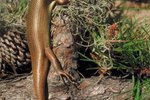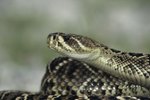
Pygmy rattlesnakes, as a small and cryptic species, can be difficult to study in the wild. Continuing research by herpetologists will provide a more complete understanding, but a picture of their lives has emerged over the last few decades. The data paint a portrait of miniaturized rattlesnakes that live very different lives than their larger cousins.
Description
Unlike the fragmented scales on the heads of typical rattlesnakes, pigmy rattlesnakes have nine large, shield-like scales on the top of their heads. Florida’s native pigmies -- dusky pigmies (Sistrurus miliarius barbouri) -- typically have gray ground colors with a row of darker, square blotches dorsally. Additionally, a red to orange stripe is usually present down the length of their bodies. The rattle of a pigmy rattlesnake is not only small in terms of absolute size; they are proportionally smaller than the rattles of most species. The rattles break easily as well, and long strands of rattles are very rare. In juveniles, the tail and rattle are bright yellow.
Habitat and Range
Dusky pigmy rattlesnakes live throughout the coastal plain of the southeastern U.S. and most of Florida. Though Florida specimens often prefer forested areas near a permanent water source, unlike many of their larger cousins that have more specific habitat preferences, pigmy rattlesnakes are quite adaptable, and are capable of living in most terrestrial habitats. Pigmy rattlesnakes are the most common venomous species in the state.
Activity Patterns
Pigmy rattlesnakes have small home ranges. Though they hibernate in the northern portions of their range, a 1996 study by Peter G. May et al reported that the central Florida pigmy rattlesnakes in their study area were active during all months of the year. When temporary cold weather forces these snakes to become inactive, they typically retreat under cover rather than move to discrete hibernacula, as most large rattlesnake species do.
Prey and Predators
These snakes primarily prey on lizards, though they also eat rodents, frogs, insects and other snakes from time to time. Pigmy rattlesnakes often spend long periods -- up to three weeks at a time -- perching on dead logs, attempting to ambush lizards that use the logs as runways. Because of their small size, pigmy rattlesnakes are likely vulnerable to a variety of predators. It is difficult for scientists to determine specific species that prey on pigmy rattlesnakes, May et al. suggest raccoons (Procyon lotor), black racers (Coluber constrictor), barred owls (Strix varia) and red-shouldered hawks (Buteo lineatus) as potential predators at their central Florida study site. Pigmy rattlesnakes do not usually sound their rattles defensively, instead preferring to remain camouflaged or flee. They will bite in self-defense, but their tiny fangs and small quantities of venom do not provide the same degree of protection from which their larger relatives benefit.
Reproduction
In 1995, Terence M. Farrell et al, investigated the reproductive habits of pigmy rattlesnakes in central Florida. The team found that adults mate in September and October and the incredibly small young -- perhaps 5 inches in length -- are born live, 10 to 11 months later, in mid-August. In contrast to larger species that take five years or longer to mature, pigmy rattlesnakes mature remarkably quickly -- a 2010 study by Kevin Robert Messenger found that female pigmy rattlesnakes matured at an average of 2.1 years after their birth, while males took 2.7 years to mature.
References
- Savannah River Ecology Laboratory: Pigmy Rattlenskae (Sistrurus miliarius)
- Animal Diversity Web: Sistrurus Miliarius
- Marshall University: Growth and Age at Reproductive Maturity of the Carolina Pigmy Rattlesnake, Sistrurus M. Miliarius (Reptilia: Serpentes)
- Stetson University: The Pigmy Rattlesnake (Sistrurus Miliarius)
- Copeia: Seasonal Abundance and Activity of a Rattlesnake (Sistrurus Miliarius Barbouri) in Central Florida
- Journal of Herpetology: Reproduction in the Rattlesnake, Sistrurus Miliarius Barbouri, in Central Florida
Resources
Photo Credits
-
Jupiterimages/Photos.com/Getty Images




